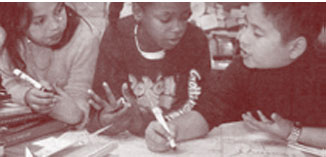



Roosevelt Elementary School: Differentiation of Instruction and English as a Second Language
Long Beach, California
Over 85% of the students who enter kindergarten in our school speak Spanish as their primary language. By law, we are required to differentiate the instructional practices based on the level of English-language proficiency of students. Theoretically, differentiation seems so simple: Teach differently to different students based on their individual needs. Easier said than done. However, one of the differences that Thinking Maps has made at my school is that teachers teach the same content to various groups in their classroom, but they have begun to provide alternate means for students to access and to show what they know. For example, some teachers expect students to use the Thinking Maps as processes to a final product, while others expect students to use the tools as a final product to demonstrate their thinking and comprehension of the content.

Stefanie Holzman, principal of Roosevelt Elementary School in Long Beach, California, is interviewed in a classroom about differentiation by David Hyerle. Roosevelt Elementary School is an urban, inner city, K–5 school of 1200 minority students (85% of those entering with Spanish as their primary language) that continues to have extraordinary success with teacher and student thinking skills including consistent growth on the state API test scores well beyond the state expectations. The video clip Differentiation in a Multilingual School.
![]() Watch the Differentiation in a Multilingual School in Quicktime (2:23)
Watch the Differentiation in a Multilingual School in Quicktime (2:23)
![]() Watch the Differentiation in a Multilingual School in Windows Media Player (2:23)
Watch the Differentiation in a Multilingual School in Windows Media Player (2:23)
In one of the third-grade classes, the students were expected to understand the similarities and differences between two planets. All students were required to complete a Double Bubble Map comparing and contrasting the two planets, which was the stated outcome of the lesson. However, in order to differentiate the lesson, students who were fluent in English were also expected to write a report that contained this information. Students less fluent in English needed only to create the Double Bubble Map. The teacher was able to evaluate the factual and conceptual learning by every student using either strategy (the map alone or the map and writing). With fluent English speakers, she was also able to evaluate their ability to communicate their learning in writing, something she already knew the less fluent English speakers would not yet be able to do. Of course, it is also essential to have the students who are not fluent in English begin to write from the Thinking Maps, as this provides the bridge from their primary language to the mainstream spoken and written form. As a first language for thinking, the maps became vocabulary builders, visible organizers, and starting points for writing in a second language.
The important point here is that the teachers are able to assess content learning and use student maps as data points to see whether or not it is language that is getting in the way of understanding or if there are content misconceptions that need reteaching. It is often difficult to determine how much limited English-proficient students understand of what is taught. If a teacher wants to know what a second language learner has learned, does the teacher ask the student to use the second-language if the student does not have verbal or written fluency? If assignments ask them to write what they know, these students often drown in the English language. They have to figure out the vocabulary, the syntax, the spelling, and the punctuation of English and at the same time remember the content they have learned. The results are that teachers often evaluate the students' English skills and sentence construction and not their content knowledge or their reasoning. However, when teachers ask students to use Thinking Maps to demonstrate what they know, then the students do not have to focus on English and can use their mental energies to communicate what they know about the content. They do not even have to use words to convey this information. In most cases. Thinking Maps lend themselves to visuals (e.g., drawings or pictures from magazines) to communicate the content.
More information about Roosevelt Elementary School is part of the book Student Successes With Thinking Maps — read excerpts from this chapter and other chapters about the student successes.